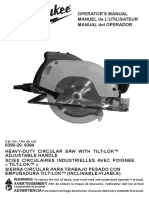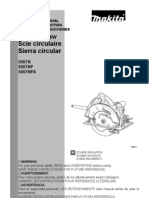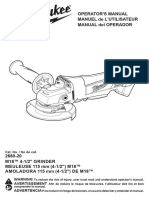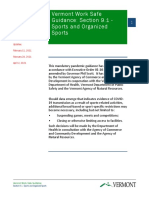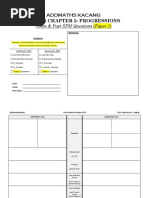Ryobi Manual
Ryobi Manual
Uploaded by
uselessname11Copyright:
Available Formats
Ryobi Manual
Ryobi Manual
Uploaded by
uselessname11Original Description:
Original Title
Copyright
Available Formats
Share this document
Did you find this document useful?
Is this content inappropriate?
Copyright:
Available Formats
Ryobi Manual
Ryobi Manual
Uploaded by
uselessname11Copyright:
Available Formats
ORIGINAL INSTRUCTIONS
Cordless Circular
Saw
RWSL1801
Important!
It is essential that you read the instructions in this manual before operating
this machine.
Subject to technical modications.
Safety
1
GENERAL POWER TOOL SAFETY WARNINGS
WARNING
Read all safety warnings and all instructions. Failure
to follow the warnings and instructions may result in
electric shock, re and/or serious injury.
Save all warnings and instructions for future reference.
The term power tool in the warnings refers to your
mains-operated (corded) power tool or battery-operated
(cordless) power tool.
WORK AREA SAFETY
Keep work area clean and well lit. Cluttered or dark
areas invite accidents.
Do not operate power tools in explosive
atmospheres, such as in the presence of flammable
liquids, gases or dust. Power tools create sparks
which may ignite the dust or fumes.
Keep children and bystanders away while operating
a power tool. Distractions can cause you to lose
control.
ELECTRICAL SAFETY
Power tool plugs must match the outlet. Never
modify the plug in any way. Do not use any adapter
plugs with earthed (grounded) power tools.
Unmodified plugs and matching outlets will reduce risk
of electric shock.
Avoid body contact with earthed or grounded
surfaces, such as pipes, radiators, ranges and
refrigerators. There is an increased risk of electric
shock if your body is earthed or grounded.
Do not expose power tools to rain or wet conditions.
Water entering a power tool will increase the risk of
electric shock.
Do not abuse the cord. Never use the cord for
carrying, pulling or unplugging the power tool.
Keep cord away from heat, oil, sharp edges or
moving parts. Damaged or entangled cords increase
the risk of electric shock.
When operating a power tool outdoors, use an
extension cord suitable for outdoor use. Use of a
cord suitable for outdoor use reduces the risk of electric
shock.
If operating a power tool in a damp location is
unavoidable, use a residual current device (RCD)
protected supply. Use of an RCD reduces the risk of
electric shock.
PERSONAL SAFETY
Stay alert, watch what you are doing and use
common sense when operating a power tool. Do
not use a power tool while you are tired or under the
influence of drugs, alcohol or medication. A moment
of inattention while operating power tools may result in
serious personal injury.
Use personal protective equipment. Always wear
eye protection. Protective equipment such as dust
mask, non-skid safety shoes, hard hat or hearing
protection used for appropriate conditions will reduce
personal injuries.
Prevent unintentional starting. Ensure the switch
is in the off-position before connecting to power
source and/or battery pack, picking up or carrying
the tool. Carrying power tools with your finger on the
switch or energising power tools that have the switch
on invites accidents.
Remove any adjusting key or wrench before turning
the power tool on. A wrench or a key left attached to
a rotating part of the power tool may result in personal
injury.
Do not overreach. Keep proper footing and balance
at all times. This enables better control of the power
tool in unexpected situations.
Dress properly. Do not wear loose clothing or
jewellery. Keep your hair, clothing and gloves away
from moving parts. Loose clothes, jewellery or long
hair can be caught in moving parts.
If devices are provided for the connection of dust
extraction and collection facilities, ensure these are
connected and properly used. Use of dust collection
can reduce dust-related hazards.
POWER TOOL USE AND CARE
Do not force the power tool. Use the correct power
tool for your application. The correct power tool will
do the job better and safer at the rate for which it was
designed.
Do not use the power tool if the switch does not turn
it on and off. Any power tool that cannot be controlled
with the switch is dangerous and must be repaired.
Disconnect the plug from the power source and/or
the battery pack from the power tool before making
any adjustments, changing accessories or storing
power tools. Such preventive safety measures reduce
the risk of starting the power tool accidentally.
Store idle power tools out of the reach of children
and do not allow persons unfamiliar with the power
tool or these instructions to operate the power tool.
Power tools are dangerous in the hands of untrained
users.
Maintain power tools. Check for misalignment or
binding of moving parts, breakage of parts and any
other condition that may affect the power tools
operation. If damaged, have the power tool repaired
before use. Many accidents are caused by poorly
maintained power tools.
Keep cutting tools sharp and clean. Properly
maintained cutting tools with sharp cutting edges are
less likely to bind and are easier to control.
Use the power tool, accessories and tool bits etc,
in accordance with these instructions, taking into
Safety
2
account the working conditions and the work to
be performed. Use of the power tool for operations
different from those intended could result in a
hazardous situation.
BATTERY TOOL USE AND CARE
Recharge only with the charger specified by the
manufacturer. A charger that is suitable for one type
of battery pack may create a risk of fire when used with
another battery pack.
Use power tools only with specifically designated
battery packs. Use of any other battery packs may
create a risk of injury and fire.
When battery pack is not in use, keep it away from
other metal objects, like paper clips, coins, keys,
nails, screws or other small metal objects that can
make a connection from one terminal to another.
Shorting the battery terminals together may cause
burns or a fire.
Under abusive conditions, liquid may be ejected
from the battery; avoid contact. If contact
accidentally occurs, flush with water. If liquid
contacts eyes, additionally seek medical help.
Liquid ejected from the battery may cause irritation or
burns.
SERVICE
Have your power tool serviced by a qualified repair
person using only identical replacement parts.
This will ensure that the safety of the power tool is
maintained.
SPECIAL SAFETY RULES
DANGER! Keep hands away from cutting area and
the blade. Keep your second hand on auxiliary
handle, or motor housing. If both hands are holding
the saw, they cannot be cut by the blade.
Do not reach underneath the workpiece. The guard
cannot protect you from the blade below the workpiece.
Adjust the cutting depth to the thickness of the
workpiece. Less than a full tooth of the blade teeth
should be visible below the workpiece.
Never hold piece being cut in your hands or across
your leg. Secure the workpiece to a stable platform.
It is important to support the work properly to minimize
body exposure, blade binding, or loss of control.
Hold power tool by insulated gripping surfaces
when performing an operation where the cutting
tool may contact hidden wiring or its own cord.
Contact with a live wire will also make exposed metal
parts of the power tool live and shock the operator.
When ripping always use a rip fence or straight
edge guide. This improves the accuracy of cut and
reduces the chance of blade binding.
Always use blades with correct size and shape
(diamond versus round) of arbour holes. Blades that
do not match the mounting hardware of the saw will run
eccentrically, causing loss of control.
Never use damaged or incorrect blade washers
or bolt. The blade washers and bolt were specially
designed for your saw, for optimum performance and
safety of operation.
CAUSES AND OPERATOR PREVENTION OF KICK-
BACK:
kickback is a sudden reaction to a pinched, bound or
misaligned saw blade, causing an uncontrolled saw to
lift up and out of the workpiece toward the operator;
when the blade is pinched or bound tightly by the kerf
closing down, the blade stalls and the motor reaction
drives the unit rapidly back toward the operator;
if the blade becomes twisted or misaligned in the cut,
the teeth at the back edge of the blade can dig into the
top surface of the wood causing the blade to climb out
of the kerf and jump back toward the operator.
Kickback is the result of saw misuse and/or incorrect
operating procedures or conditions and can be avoided by
taking proper precautions as given below.
Maintain a firm grip with both hands on the saw
and position your arms to resist kickback forces.
Position your body to either side of the blade, but
not in line with the blade. Kickback could cause the
saw to jump backwards, but kickback forces can be
controlled by the operator, if proper precautions are
taken.
When blade is binding, or when interrupting a cut
for any reason, release the trigger and hold the saw
motionless in the material until the blade comes
to a complete stop. Never attempt to remove the
saw from the work or pull the saw backward while
the blade is in motion or kickback may occur.
Investigate and take corrective actions to eliminate the
cause of blade binding.
When restarting a saw in the workpiece, centre the
saw blade in the kerf and check that saw teeth are
not engaged into the material. If saw blade is binding,
it may walk up or kickback from the workpiece as the
saw is restarted.
Support large panels to minimise the risk of blade
pinching and kickback. Large panels tend to sag
under their own weight. Supports must be placed under
the panel on both sides, near the line of cut and near
the edge of the panel.
Do not use dull or damaged blades. Unsharpened
or improperly set blades produce narrow kerf causing
excessive friction, blade binding and kickback.
Blade depth and bevel adjusting locking levers
must be tight and secure before making cut. If blade
adjustment shifts while cutting, it may cause binding
and kickback.
Use extra caution when making a plunge cut into
existing walls or other blind areas. The protruding
blade may cut objects that can cause kickback.
Safety
3
Check lower guard for proper closing before each
use. Do not operate the saw if lower guard does not
move freely and close instantly. Never clamp or
tie the lower guard into the open position. If saw is
accidentally dropped, lower guard may be bent. Raise
the lower guard with the retracting handle and make
sure it moves freely and does not touch the blade or any
other part, in all angles and depths of cut.
Check the operation of the lower guard spring. If
the guard and the spring are not operating properly,
they must be serviced before use. Lower guard may
operate sluggishly due to damaged parts, gummy
deposits, or a build-up of debris.
Lower guard may be retracted manually only for
special cuts such as plunge cuts and compound
cuts. Raise lower guard by retracting handle and
as soon as blade enters the material, the lower
guard must be released. For all other sawing, the
lower guard should operate automatically.
Always observe that the lower guard is covering the
blade before placing saw down on bench or floor.
An unprotected, coasting blade will cause the saw to
walk backwards, cutting whatever is in its path. Be
aware of the time it takes for the blade to stop after
switch is released.
LASER SAFETY
Do not stare into beam during operation.
Do not project the laser beam directly into the eyes of
others.
Serious eye injury could result.
Do not place the laser in a position, that may cause
anyone to stare into the laser beam intentionally or
unintentionally.
Do not use optical tools to view the laser beam.
Do not operate the laser around children or allow
children to operate the laser.
Do not attempt to repair the laser device by yourself.
Do not attempt to change any parts of the laser device
by yourself.
Any repairs must only be carried out by the laser
manufacturer or authorized service agent.
Do not replace the laser with a different type.
INTENDED USE
You may use this product for cutting all types of wood.
MAINTENANCE
When servicing, use only identical Ryobi replacement
parts. Use of any other parts may create a hazard or
cause product damage.
Avoid using solvents when cleaning plastic parts. Most
plastics are susceptible to damage from various types
of commercial solvents and may be damaged by their
use. Use clean cloths to remove dirt, dust, oil, grease,
etc.
Do not attempt to modify this tool or create accessories
not recommended for use with this tool.
ENVIRONMENTAL PROTECTION
Recycle raw materials instead of disposing
of as waste. The machine, accessories
and packaging should be sorted for
environmental-friendly recycling.
SYMBOL
Safety alert
V Volts
Revolutions per minute
Direct current
Wear ear protection
Wear eye protection
Laser radiation.
Do not stare into beam.
Recycle
Waste electrical products should not be
disposed of with household waste. Please
recycle where facilities exist. Check
with your Local Authority or retailer for
recycling advice.
ICONS IN THIS MANUAL
Safety
Getting started
Safety
4
Operation
Maintenance
Safety alert
Information
Lock
Unlock
Wear safety gloves
Disconnect battery
Waiting time
5
6
Getting started
3
1
3
4
2
4
7
Getting started
3
3
5s 3s
5
3
Operation
8
40
45
10 - 45 mm 10 - 45 mm
1
2
3
Operation
9
2
3
1
1
5s 3s
3
2
Operation
10
5s 3s
3
4
2
3
1
3
1
2
Maintenance
11
0 45
2
3
1
1 2
2
1
0 45 0 45
3
1
2
Maintenance
12
3
3
1
2
13
Maintenance
3
3
1
2
2
0
1
1
1
2
2
3
v
1
PRODUCT SPECIFICATIONS
Motor 18 V
Blade diameter 150 mm
Blade arbor 10 mm
Cutting depth at 0 45 mm
Cutting depth at 45 32 mm
No-Load speed 4,700 min
-1
BATTERY AND CHARGER
Model Compatible battery
pack (not included)
Compatible charger
(not included)
RWSL1801
BPL-1820
BPL-1815
BCL14181H
BCL14183H
BCL1418
BCS618
BPP-1815
BPP-1817
BPP-1813
BCA-180
BC-1815S
BC-1800
BCS618
BCL1418
BCL14181H
BCL14183H
961067917-01
You might also like
- Q& A Electronic DevicesDocument39 pagesQ& A Electronic DevicesMUHAMMED SHAMVILNo ratings yet
- Craftsman Cordless Laser Trim Saw Model 315.115780 PDFDocument28 pagesCraftsman Cordless Laser Trim Saw Model 315.115780 PDFAKA "Tomás de Torquemada"No ratings yet
- System Design SpecificationDocument8 pagesSystem Design Specificationapi-278499472No ratings yet
- Operator'S Manual 1/2 In. (13 MM) THREE SPEED Cordless Hammer Drill Model No. Hd1830Document20 pagesOperator'S Manual 1/2 In. (13 MM) THREE SPEED Cordless Hammer Drill Model No. Hd1830Nix CawaonNo ratings yet
- RPD18 - 18V ONE+ Hammer Drill All Rounder 4.0Ah KitDocument12 pagesRPD18 - 18V ONE+ Hammer Drill All Rounder 4.0Ah Kitropeman13No ratings yet
- M18CCS66 Product ManualDocument12 pagesM18CCS66 Product Manualcbturtle10No ratings yet
- Operator'S Manual Manuel de L'Utilisateur Manual Del OperadorDocument32 pagesOperator'S Manual Manuel de L'Utilisateur Manual Del OperadorInstructores InsternosNo ratings yet
- RTBS18X Brushless 210mm Table Saw ToolDocument32 pagesRTBS18X Brushless 210mm Table Saw Toolropeman13No ratings yet
- RCG18 - User ManualDocument8 pagesRCG18 - User Manualropeman13No ratings yet
- Operator'S Manual Power Planer Model No. HPL50: Double InsulatedDocument18 pagesOperator'S Manual Power Planer Model No. HPL50: Double InsulatedThuận ThiênNo ratings yet
- RROS18 - User ManualDocument12 pagesRROS18 - User Manualropeman13No ratings yet
- Sierra CirculaDocument32 pagesSierra CirculaMaritza HernandezNo ratings yet
- Ryobi R36XBLW50 - 36V HP Brushless 600CFM Jet Blower 4ah KitDocument16 pagesRyobi R36XBLW50 - 36V HP Brushless 600CFM Jet Blower 4ah Kitropeman13No ratings yet
- Warning Avertissement Advertencia: Cat. No. / No de CatDocument36 pagesWarning Avertissement Advertencia: Cat. No. / No de Catchris CruzNo ratings yet
- PDFDocument19 pagesPDFPsiNo ratings yet
- 36V HP™ Brushless 3540cm Line Trimmer 4.0Ah KitDocument24 pages36V HP™ Brushless 3540cm Line Trimmer 4.0Ah Kitropeman13No ratings yet
- 58-14-6477d7 Circular Saw Manual Usuario MilwaukeeDocument40 pages58-14-6477d7 Circular Saw Manual Usuario MilwaukeeRicardo MedranoNo ratings yet
- Operator'S Manual Manuel de L'Utilisateur Manual Del OperadorDocument24 pagesOperator'S Manual Manuel de L'Utilisateur Manual Del Operadorashtaroths1005sNo ratings yet
- Operator'S Manual Manuel de L'Utilisateur Manual Del OperadorDocument24 pagesOperator'S Manual Manuel de L'Utilisateur Manual Del Operadord sNo ratings yet
- Ds 1100Document12 pagesDs 1100DannyNo ratings yet
- RRT18X - 18V ONE+ HP Brushless Rotary ToolDocument20 pagesRRT18X - 18V ONE+ HP Brushless Rotary Toolropeman13No ratings yet
- Manual Sierra B&DDocument56 pagesManual Sierra B&DLadislao ChavezNo ratings yet
- RAG18X - 18V ONE+ HP™ Brushless 125mm Angle Grinder Tool OnlyDocument16 pagesRAG18X - 18V ONE+ HP™ Brushless 125mm Angle Grinder Tool Onlyropeman13No ratings yet
- Manual 5007NDocument32 pagesManual 5007NKevin WalshNo ratings yet
- Rotozip RTM01 Spiral SawDocument40 pagesRotozip RTM01 Spiral SawprotobooksNo ratings yet
- 961075678-01_18V ONE+ Hammer Drill All Rounder 4.0Ah KitDocument8 pages961075678-01_18V ONE+ Hammer Drill All Rounder 4.0Ah Kitropeman13No ratings yet
- GSS160 OmDocument48 pagesGSS160 OmMauricio Soto AguirreNo ratings yet
- RPD18X - 18V ONE+ HP™ Brushless Hammer Drill Tool OnlyDocument12 pagesRPD18X - 18V ONE+ HP™ Brushless Hammer Drill Tool Onlyropeman13No ratings yet
- gk1630t, 1640t - GB - md09Document16 pagesgk1630t, 1640t - GB - md09Anonymous Y64YEIlNo ratings yet
- Operator'S Manual Manuel de L'Utilisateur Manual Del OperadorDocument24 pagesOperator'S Manual Manuel de L'Utilisateur Manual Del Operadorashtaroths1005sNo ratings yet
- m18_fuel_272720Document48 pagesm18_fuel_272720Michael RussellNo ratings yet
- Operator'S Manual Manuel de L'Utilisateur Manual Del OperadorDocument13 pagesOperator'S Manual Manuel de L'Utilisateur Manual Del Operadornvh2nhgztmNo ratings yet
- Milwaukee M18Document20 pagesMilwaukee M18Eduardo Modesto AguilarNo ratings yet
- Circular Saw Scie Circulaire Sierra Circular: Instruction Manual Manuel D'Instruction Manual de InstruccionesDocument32 pagesCircular Saw Scie Circulaire Sierra Circular: Instruction Manual Manuel D'Instruction Manual de InstruccionesmarioNo ratings yet
- 192420_7424736_installationDocument7 pages192420_7424736_installationXavier LignaNo ratings yet
- Pulidora Inalambrica 2738 MilwaukeeDocument16 pagesPulidora Inalambrica 2738 MilwaukeeMARIA FERNo ratings yet
- Operator'S Manual Manuel de L'Utilisateur Manual Del OperadorDocument24 pagesOperator'S Manual Manuel de L'Utilisateur Manual Del OperadorfdonyNo ratings yet
- Operator'S Manual Manuel de L'Utilisateur Manual Del OperadorDocument29 pagesOperator'S Manual Manuel de L'Utilisateur Manual Del Operadoranilr008No ratings yet
- Ryobi OSS500 Oscillating Spindle Sander Owners ManualDocument16 pagesRyobi OSS500 Oscillating Spindle Sander Owners ManualScott ArnoldNo ratings yet
- makita4200NH Saw PDFDocument20 pagesmakita4200NH Saw PDFtkmrmrNo ratings yet
- Manual Pulidora 9 Milwaukee Serial B43CD15010643Document36 pagesManual Pulidora 9 Milwaukee Serial B43CD15010643M Vega Vega Mahecha0% (1)
- Dremel ManualDocument76 pagesDremel ManualJohn Paul RicheyNo ratings yet
- MilwaukeeDocument28 pagesMilwaukeeacostarobles.matiasNo ratings yet
- Operator'S Manual Manuel de L'Utilisateur Manual Del OperadorDocument28 pagesOperator'S Manual Manuel de L'Utilisateur Manual Del OperadorJunky mikeNo ratings yet
- Operator'S Manual Manuel de L'Utilisateur Manual Del OperadorDocument20 pagesOperator'S Manual Manuel de L'Utilisateur Manual Del Operadorbmatthew1111No ratings yet
- HAAHHSBZNNSDocument16 pagesHAAHHSBZNNSsouthsideroofrestorationsNo ratings yet
- 34' Hex Demolition Hammer 5337-20Document28 pages34' Hex Demolition Hammer 5337-201092 hanna (primary soul)No ratings yet
- 4-1/2in. Angle Grinder: Owner'S ManualDocument14 pages4-1/2in. Angle Grinder: Owner'S ManualboomissyNo ratings yet
- Pulidora MilwaukiDocument36 pagesPulidora Milwaukialvarodejesusg3No ratings yet
- Craftman Power Saw ManualDocument29 pagesCraftman Power Saw ManualTrevor GarveyNo ratings yet
- Genesis 18V Drill-Driver GCD18BK2 ManualDocument13 pagesGenesis 18V Drill-Driver GCD18BK2 ManualndnrobinNo ratings yet
- Milawuke Impact Wrench DatasheetDocument16 pagesMilawuke Impact Wrench DatasheetAhmad Hady100% (1)
- Operator'S Manual Manuel de L'Utilisateur Manual Del OperadorDocument24 pagesOperator'S Manual Manuel de L'Utilisateur Manual Del OperadorAmjad AlQasrawiNo ratings yet
- Axminster AWSS-18 Flex - Manual PDFDocument26 pagesAxminster AWSS-18 Flex - Manual PDFOlesea LebedevNo ratings yet
- Warning Avertissement Advertencia: Cat. No. / No de CatDocument32 pagesWarning Avertissement Advertencia: Cat. No. / No de Catashtaroths1005sNo ratings yet
- EXPAND-IT 45cm Line Trimmer AttachmentDocument20 pagesEXPAND-IT 45cm Line Trimmer Attachmentropeman13No ratings yet
- Operator'S Manual Manuel de L'Utilisateur Manual Del OperadorDocument20 pagesOperator'S Manual Manuel de L'Utilisateur Manual Del OperadorTram E29No ratings yet
- Milwaukee Drill 2803 - User ManualDocument20 pagesMilwaukee Drill 2803 - User ManualChrist MorinNo ratings yet
- Operator'S Manual Manuel de L'Utilisateur Manual Del OperadorDocument16 pagesOperator'S Manual Manuel de L'Utilisateur Manual Del Operadorashtaroths1005sNo ratings yet
- RTR18C_Brushless 6.4mm (1-4”) Trim Router Tool OnlyDocument12 pagesRTR18C_Brushless 6.4mm (1-4”) Trim Router Tool Onlyropeman13No ratings yet
- Operator'S Manual Manuel de L'Utilisateur Manual Del OperadorDocument19 pagesOperator'S Manual Manuel de L'Utilisateur Manual Del OperadorAlvaro Fernando Reyes CastañedaNo ratings yet
- Ultimate Guide to Home Repair and Improvement, Updated Edition: Proven Money-Saving Projects; 3,400 Photos & IllustrationsFrom EverandUltimate Guide to Home Repair and Improvement, Updated Edition: Proven Money-Saving Projects; 3,400 Photos & IllustrationsRating: 3.5 out of 5 stars3.5/5 (8)
- Protocol-Aware ATE: Complement or Competitor For Structural Testing?Document1 pageProtocol-Aware ATE: Complement or Competitor For Structural Testing?siva_iisc7275No ratings yet
- Creating Stretch Clusters With StorMagic SvSAN DigitalDocument4 pagesCreating Stretch Clusters With StorMagic SvSAN Digitalpk bsdkNo ratings yet
- ecologOne_ReleaseNotesDocument10 pagesecologOne_ReleaseNotesRodrigo MolgadoNo ratings yet
- Mid-Term Exam IIa ANSWER KEYchemDocument8 pagesMid-Term Exam IIa ANSWER KEYchemphanprideNo ratings yet
- Updated Vermont Guidance For Adult Recreation, Youth Sports LeaguesDocument9 pagesUpdated Vermont Guidance For Adult Recreation, Youth Sports LeaguesAlex AbramiNo ratings yet
- Introduction To The Study of LiteratureDocument59 pagesIntroduction To The Study of LiteratureTam FerrolNo ratings yet
- What Are The Different Types of PollutionDocument9 pagesWhat Are The Different Types of PollutionPatricia DurandNo ratings yet
- DCS AV-8B Harrier GuideDocument278 pagesDCS AV-8B Harrier GuideDarksniped flying madnessNo ratings yet
- AEL - 3 Sem 5 - NotesDocument33 pagesAEL - 3 Sem 5 - Notesash224696No ratings yet
- WASH AssignmentDocument2 pagesWASH AssignmentAbdinasir Farah JamaNo ratings yet
- Company Profile Bina Pertiwi New FinalDocument2 pagesCompany Profile Bina Pertiwi New FinalAudy TanhatiNo ratings yet
- Exact Differential EquationsDocument33 pagesExact Differential EquationsCHESTER MICKO GERTESNo ratings yet
- Geometric ConstructionDocument30 pagesGeometric ConstructionHarshika100% (1)
- Abney LevelDocument10 pagesAbney LevelBakhtiyar Q.KhawajaNo ratings yet
- Rina LinguisticDocument2 pagesRina LinguisticUlfaNo ratings yet
- Lesson 1:: The Cycle of Day and NightDocument5 pagesLesson 1:: The Cycle of Day and NightRavineel KumarNo ratings yet
- Sleep Information Sheet - 06 - Imagery RescriptingDocument2 pagesSleep Information Sheet - 06 - Imagery RescriptingMiracle WhitesNo ratings yet
- 01 F4C5 Progressions AMKacangDocument7 pages01 F4C5 Progressions AMKacangZulkarnain IrsyadNo ratings yet
- SN751178NDocument16 pagesSN751178Nuser1ilaNo ratings yet
- Catalogo EngrenagemDocument12 pagesCatalogo EngrenagemRafael PachecoNo ratings yet
- Basic Electrical and Electronics Engineering (BEEE) (I Year I Sem) Unit - I Short QuestionsDocument4 pagesBasic Electrical and Electronics Engineering (BEEE) (I Year I Sem) Unit - I Short Questionsmonika0404No ratings yet
- Wilfred Owen ExposureDocument3 pagesWilfred Owen ExposureTreesa VarugheseNo ratings yet
- Book List Secondary School (2023 24) .Ad9e09c5Document3 pagesBook List Secondary School (2023 24) .Ad9e09c5luvish1805No ratings yet
- Vata Dosha in Ayurveda - Ayur Times PDFDocument15 pagesVata Dosha in Ayurveda - Ayur Times PDFAnand GNo ratings yet
- Lewis UrryDocument2 pagesLewis UrryGapuk MaboekNo ratings yet
- 2 - 7-1 - 04-2003 Clinical EvaluationDocument20 pages2 - 7-1 - 04-2003 Clinical EvaluationGABYNo ratings yet
- Evaluation Sheet For Master TeacherDocument2 pagesEvaluation Sheet For Master TeacherAllan Tomas60% (5)
- Bacterial, Viral, Polysaccharides, Recombinant and DNA VaccinesDocument15 pagesBacterial, Viral, Polysaccharides, Recombinant and DNA VaccinesAshwini_MCCNo ratings yet











